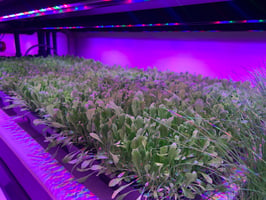5. The essential elements of a hydroponic system
Hydroponics only looks complex from the outside. In reality, every system-from the simplest to the most professional-relies on the same basic components. Understanding these elements is the first step to choosing the right system, avoiding mistakes, and building a truly efficient crop.
In this guide I explain in a clear and practical way what the essential elements of a hydroponic system are, what they are used for, and how they must work together to ensure healthy and fast plant growth.
1. The water tank and the nutrient solution
The tank is the heart of the system: it contains water mixed with mineral nutrients.
A good tank must ensure:
-
temperature stability
-
protection from light (to avoid algae)
-
food-safe materials
-
easy access for cleaning and maintenance
In traditional greenhouses, external tanks or tubs are used.
In more modern systems-such as Tomato+ greenhouses-the tank is integrated and automatically monitored by software, which adjusts levels, topping up, and parameters in real time.
2. The water pump.
The pump maintains water flow in recirculating systems and oxygenates the solution, preventing stagnation.
Important features:
-
flow rate appropriate for the number of plants
-
continuous or scheduled operation
-
high reliability to avoid critical blockages
-
reduced energy consumption
In professional Tomato+ systems, pumps are automated and cloud-controlled, with optimized cycles based on the variety being grown.
3. The water distribution system.
Depending on the type of system (NFT, DWC, ebb&flow, drip...), water must:
-
flow in a thin film
-
invade and drain a tank
-
drip onto the roots
-
keep the roots fully submerged and oxygenated
Pipes, conduits, and fittings determine flow stability and the ability of the system to properly feed each plant.
4. Aeration and oxygenation.
Oxygen is critical in roots.
It is achieved through:
-
porous stones and air pumps (DWC)
-
continuous flows (NFT)
-
fill/empty cycles (ebb&flow).
Oxygenation is one of the parameters that differentiates a mediocre plant from a performing one.
In Tomato+ greenhouses, oxygenation is managed by algorithms and sensors that maintain optimal conditions 24/7.
5. Growing lights (LEDs).
Light is an essential technical element.
LEDs for hydroponics:
-
use specific spectrum to promote photosynthesis and morphology
-
ensure uniformity
-
reduce consumption and emissions
-
allow customized photoperiod cycles
Tomato+ LED modules are 6-channel independent, allowing complex light simulations tailored to each variety.
6. Growth media: pots, baskets, substrates.
Although hydroponics does not use soil, you still need a substrate to keep the plant in place.
The most common ones:
-
phenolic sponge
-
coconut fiber
-
rock wool
-
perlite/ vermiculite
-
mixed substrates
With Tomato+, compostable pods replace these substrates: biodegradable, sterile, lightweight, with optimized seed distribution.
7. Sensors and control instruments
Today, a hydroponic system without sensors is simply obsolete.
Critical parameters:
-
EC (conductivity)
-
pH
-
water temperature
-
water level
-
light intensity
-
humidity and air temperature
In a domestic system, they are adjusted manually.
In Tomato+ solutions, sensors generate millions of datapoints that feed artificial intelligence, automatically improving growth cycles.
8. The software (in advanced systems)
In modern systems, the software part is what makes the real difference.
Advanced software allows:
-
remote monitoring
-
automation of cycles
-
growth forecasting
-
continuous optimizations (AI)
-
data logs for each plant
Tomato+ uses a cloud system with Dynamic Growth Plan algorithms based on real-time data collection.
9. Structure and growing containers
The structure must be:
-
sturdy
-
modular
-
easy to clean
-
impervious to light
-
suitable for verticalization
Tomato+ greenhouses (Horto2, Horto4, Horto Professional) integrate these elements into a compact, scalable design ready for indoor and outdoor use.
Conclusion
The essential elements of a hydroponics system are always the same, but the quality of the whole-flows, sensors, lights, automations-really defines performance.
The goal is to make these components work harmoniously.
In Tomato+ systems, this harmony is achieved through a combination of technology, AI, and integrated design designed to grow precisely, sustainably, and replicably.
Thank you for reading this article. Keep following us to discover new content on hydroponics, vertical farming, and smart agriculture.
Tomato+ Team


